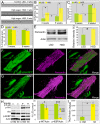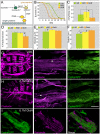A Drosophila model of high sugar diet-induced cardiomyopathy
- PMID: 23326243
- PMCID: PMC3542070
- DOI: 10.1371/journal.pgen.1003175
A Drosophila model of high sugar diet-induced cardiomyopathy
Abstract
Diets high in carbohydrates have long been linked to progressive heart dysfunction, yet the mechanisms by which chronic high sugar leads to heart failure remain poorly understood. Here we combine diet, genetics, and physiology to establish an adult Drosophila melanogaster model of chronic high sugar-induced heart disease. We demonstrate deterioration of heart function accompanied by fibrosis-like collagen accumulation, insulin signaling defects, and fat accumulation. The result was a shorter life span that was more severe in the presence of reduced insulin and P38 signaling. We provide evidence of a role for hexosamine flux, a metabolic pathway accessed by glucose. Increased hexosamine flux led to heart function defects and structural damage; conversely, cardiac-specific reduction of pathway activity prevented sugar-induced heart dysfunction. Our data establish Drosophila as a useful system for exploring specific aspects of diet-induced heart dysfunction and emphasize enzymes within the hexosamine biosynthetic pathway as candidate therapeutic targets.
Conflict of interest statement
The authors have declared that no competing interests exist.
Figures





Similar articles
-
Genetic Dissection of Nutrition-Induced Plasticity in Insulin/Insulin-Like Growth Factor Signaling and Median Life Span in a Drosophila Multiparent Population.Genetics. 2017 Jun;206(2):587-602. doi: 10.1534/genetics.116.197780. Genetics. 2017. PMID: 28592498 Free PMC article.
-
Changes in the expression of the Alzheimer’s disease-associated presenilin gene in drosophila heart leads to cardiac dysfunction.Curr Alzheimer Res. 2011 May;8(3):313-22. doi: 10.2174/156720511795563746. Curr Alzheimer Res. 2011. PMID: 21524270 Free PMC article.
-
Ablating the Rab-GTPase activating protein TBC1D1 predisposes rats to high-fat diet-induced cardiomyopathy.J Physiol. 2020 Feb;598(4):683-697. doi: 10.1113/JP279042. Epub 2020 Feb 4. J Physiol. 2020. PMID: 31845331
-
Convergence of glucose- and fatty acid-induced abnormal myocardial excitation-contraction coupling and insulin signalling.Clin Exp Pharmacol Physiol. 2006 Jan-Feb;33(1-2):152-8. doi: 10.1111/j.1440-1681.2006.04343.x. Clin Exp Pharmacol Physiol. 2006. PMID: 16445715 Review.
-
Obesity and Aging in the Drosophila Model.Int J Mol Sci. 2018 Jun 27;19(7):1896. doi: 10.3390/ijms19071896. Int J Mol Sci. 2018. PMID: 29954158 Free PMC article. Review.
Cited by
-
Origin and Development of the Adipose Tissue, a Key Organ in Physiology and Disease.Front Cell Dev Biol. 2021 Dec 21;9:786129. doi: 10.3389/fcell.2021.786129. eCollection 2021. Front Cell Dev Biol. 2021. PMID: 34993199 Free PMC article. Review.
-
A high-fat diet impacts memory and gene expression of the head in mated female Drosophila melanogaster.J Comp Physiol B. 2019 Apr;189(2):179-198. doi: 10.1007/s00360-019-01209-9. Epub 2019 Feb 27. J Comp Physiol B. 2019. PMID: 30810797 Free PMC article.
-
How does a fly die? Insights into ageing from the pathophysiology of Drosophila mortality.Geroscience. 2024 Oct;46(5):4003-4015. doi: 10.1007/s11357-024-01158-4. Epub 2024 Apr 20. Geroscience. 2024. PMID: 38642259 Free PMC article. Review.
-
Microbial solutions to dietary stress: experimental evolution reveals host-microbiome interplay in Drosophila melanogaster.Proc Biol Sci. 2025 Mar;292(2043):20242558. doi: 10.1098/rspb.2024.2558. Epub 2025 Mar 26. Proc Biol Sci. 2025. PMID: 40132628 Free PMC article.
-
Hexosamine pathway activation improves memory but does not extend lifespan in mice.Aging Cell. 2022 Oct;21(10):e13711. doi: 10.1111/acel.13711. Epub 2022 Sep 19. Aging Cell. 2022. PMID: 36124412 Free PMC article.
References
-
- Marriott BP, Cole N, Lee E (2009) National Estimates of Dietary Fructose Intake Increased from 1977 to 2004 in the United States. The Journal of Nutrition 139: 1228S–1235S. - PubMed
-
- Mellor KM, Ritchie RH, Davidoff AJ, Delbridge LMD (2010) Elevated dietary sugar and the heart: experimental models and myocardial remodeling. Canadian Journal of Physiology and Pharmacology 88: 525–540. - PubMed
-
- Selvin E, Coresh J, Golden SH, Brancati FL, Folsom AR, et al. (2005) Glycemic Control and Coronary Heart Disease Risk in Persons With and Without Diabetes: The Atherosclerosis Risk in Communities Study. Arch Intern Med 165: 1910–1916. - PubMed
-
- Rubler S, Dlugash J, Yuceoglu YZ, Kumral T, Branwood AW, et al. (1972) New type of cardiomyopathy associated with diabetic glomerulosclerosis. The American Journal of Cardiology 30: 595–602. - PubMed
Publication types
MeSH terms
Substances
Grants and funding
- (#NIH/NHLBI RO1 HL54732-16/PHS HHS/United States
- F32 DK098053/DK/NIDDK NIH HHS/United States
- T32 GM062754/GM/NIGMS NIH HHS/United States
- R01 HL054732/HL/NHLBI NIH HHS/United States
- R01 HL085481-04/HL/NHLBI NIH HHS/United States
- #R24 DK098053/DK/NIDDK NIH HHS/United States
- 5K12HD001459-12/HD/NICHD NIH HHS/United States
- P01 AG033561/AG/NIA NIH HHS/United States
- P30 DK020579/DK/NIDDK NIH HHS/United States
- P01 AG033561-02/AG/NIA NIH HHS/United States
- P01 HL0980539-02/HL/NHLBI NIH HHS/United States
- T32GM062754/GM/NIGMS NIH HHS/United States
- K12 HD001459/HD/NICHD NIH HHS/United States
- R01 HL085481/HL/NHLBI NIH HHS/United States
- T32 GM007464/GM/NIGMS NIH HHS/United States
LinkOut - more resources
Full Text Sources
Other Literature Sources
Medical
Molecular Biology Databases

